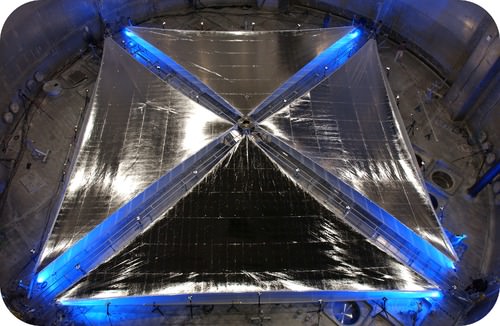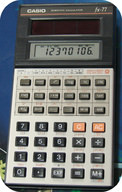13.5 光电效应
章节大纲
-
Are you a fan of science fiction?
::你是科幻小说迷吗?In some 1950s science fiction stories, one of the space travel themes was the use of solar sails for propulsion. The idea was that the photon pressure from the sun would push the sail (like wind sails) and move the space craft. What once was science fiction is now reality as solar sails are being developed and tested for modern space travel.
::在1950年代的一些科幻小说中,空间旅行的主题之一是利用太阳帆推进。 其理念是太阳光子压力将推动帆(如风帆 ) , 并移动太空飞船。 科学小说曾经是现实,因为太阳帆正在被开发和测试用于现代太空旅行。Photoelectric Effect and the Particle Nature of Light
::光电效应和光的粒子性质In 1905, Albert Einstein (1879-1955) proposed that light be described as quanta of that behave as particles. A photon is a particle of electromagnetic radiation that has zero mass and carries a quantum of energy. The energy of photons of light is quantized according to the equation. For many years, light had been described using only wave concepts, and scientists trained in classical physics found this wave-particle duality of light to be a difficult idea to accept. A key experiment that was explained by Einstein using light’s particle nature was called the photoelectric effect.
::1905年,艾伯特·爱因斯坦(1879-1955年)提议将光称为粒子行为的量子。光子是电磁辐射的粒子,其质量为零,带有能量的量子。光子的能量根据E=hv方程式量化。多年来,光线被描述时只使用了波子概念,受过古典物理学培训的科学家发现这种波粒光的双重性是一个难以接受的想法。爱因斯坦用光粒子性质解释的一项关键实验被称为光电效应。The photoelectric effect is a phenomenon that occurs when light shined onto a metal surface causes the ejection of electrons from that metal. It was observed that only certain frequencies of light are able to cause the ejection of electrons. If the frequency of the incident light is too low (red light, for example), then no electrons were ejected even if the intensity of the light was very high or it was shone onto the surface for a long time. If the frequency of the light was higher (green light, for example), then electrons were able to be ejected from the metal surface even if the intensity of the light was very low or it was shone for only a short time. This minimum frequency needed to cause ejection is referred to as the threshold frequency .
::光电效应是一种现象,当光照到金属表面时,就会产生光电效应,导致该金属电子的弹出。据观察,只有某些光频率能够导致电子的弹出。如果事件光的频率太低(例如红光),那么即使光的强度非常高,或光线在表面长时间闪烁,也不得发射电子。如果光频率较高(例如绿光),那么即使光的强度非常低,或只是短时间抛射,也能够将电子从金属表面射出。导致弹出的最短频率被称为临界频率。Classical physics was unable to explain the photoelectric effect. If classical physics applied to this situation, the electron in the metal could eventually collect enough energy to be ejected from the surface even if the incoming light was of low frequency. Einstein used the particle theory of light to explain the photoelectric effect as shown in Figure .
::古典物理学无法解释光电效应。 如果古典物理学适用于这种情况,金属中的电子最终可以收集到足够的能量从表面射出,即使射入的光线是低频的。 爱因斯坦利用光粒子理论解释光电效应,如图所示。Low frequency light (red) is unable to cause ejection of electrons from the metal surface. At or above the threshold frequency (green) electrons are ejected. Even higher frequency incoming light (blue) causes ejection of the same number of electrons but with greater speed.
::低频光(红)不能导致金属表面电子的抛射,在阈值频率(绿色)电子上或以上时会被抛射,甚至更频繁的光(蓝色)也会导致相同数量的电子的抛射,但速度更高。Consider the equation. The is the minimum energy that is required in order for the metal’s electrons to be ejected. If the incoming light’s frequency, , is below the threshold frequency, there will never be enough energy to cause electrons to be ejected. If the frequency is equal to or higher than the threshold frequency, electrons will be ejected. As the frequency increases beyond the threshold, the ejected electrons simply move faster. An increase in the intensity of incoming light that is above the threshold frequency causes the number of electrons that are ejected to increase, but they do not travel any faster. The photoelectric effect is applied in devices called photoelectric cells , which are commonly found in everyday items such as a calculator which uses the energy of light to generate electricity.
::考虑 E=hv 等式 。 E 是金属电子被抛射所需的最低能量。 如果射入的光的频率( v) 低于临界频率, 则永远不会有足够能量导致电子被抛射。 如果频率等于或高于临界频率, 电子将被抛射。 当频率超过临界值时, 弹射的电电子只需移动更快即可。 射入光的强度超过临界频率, 导致被抛射的电电子数量增加, 但没有移动得更快。 光电效应应用在被称为光电电池的装置中, 这在日常设备中常见, 比如使用光能发电的计算器。Photoelectric cells convert light energy into electrical energy which powers this calculator.
::光电电池将光能转换成电能 驱动这个计算器Launch the PLIX interactive below to determine which type of colored light has enough energy (eV) to eject an electron from the metal plate:
::启动下面的PLIX互动,以确定哪类有色光有足够的能量(eV)从金属板上喷出电子:Summary
::摘要-
Light has properties of both a wave and a particle.
::光具有波和粒子的特性。 -
The photoelectric effect is produced by light striking a metal and dislodging electrons form the surface of the metal.
::光撞击金属产生光电效应,金属表面形成迁移电子。
Review
::回顾-
What are the properties of a photon?
::光子的特性是什么? -
What does the photoelectric effect show about the properties of light?
::光电效应显示光的特性是什么? -
How does the frequency of light affect the release of photons?
::光的频率如何影响光子的释放?
-
Light has properties of both a wave and a particle.


